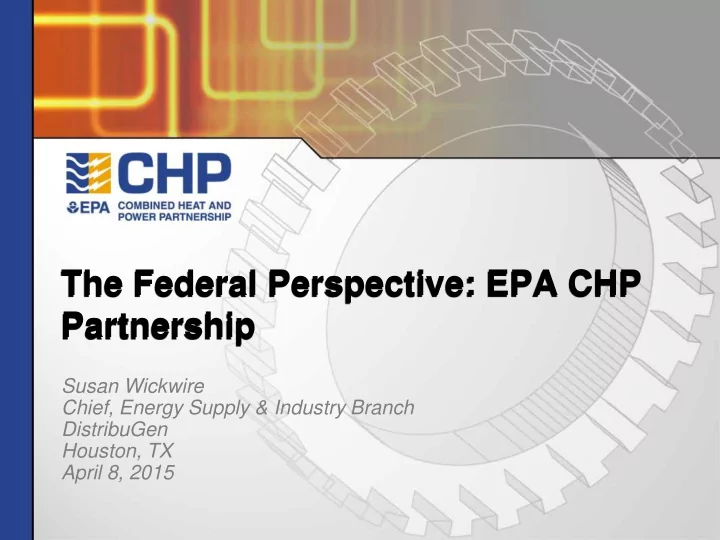

The Federal Perspective: EPA CHP Partnership Susan Wickwire Chief, Energy Supply & Industry Branch DistribuGen Houston, TX April 8, 2015
Overview • CHPP Basics • CHPP Tools and Resources • CHPP Priorities 2
EPA Combined Heat & Power Partnership (CHPP) Objective • Seeks to reduce the environmental impact of power generation by promoting the use of CHP Strategies and Actions • Targets key regulatory, utility and information barriers • Supports development of new CHP projects with credible and objective technical expertise • Offers trusted tools, guidance, and technical assistance • Recognizes superior systems through ENERGY STAR CHP Awards • Provides expertise to support EPA Clean Air Act implementation Results • Through 2013, assisted in the deployment of 917 projects by CHPP partners totaling over 6,199 MW of capacity and avoiding over 129 MMTCO 2 Website: http://www.epa.gov/chp/ 3
Almost 500 Partners… 4
CHP Partnership Resources for Project Developers • Catalog of Technologies (updated) • Project Development Handbook • CHP Emissions Calculator • Spark Spread Estimator • CHP and Clean Water State Revolving Funds Fact Sheet (new) 5
CHP Catalog of Technologies • Covers five commercially available CHP prime movers (Recip. Engine, Gas Turbine, B/S Turbine, Microturbine, Fuel Cell) – Description of common applications – Basic technology description – Cost and performance characteristics, incl. water use – Emissions and emissions control options – Future developments http://www.epa.gov/chp/technologies.html 6
Spark Spread Estimator • Enables user to conduct a very preliminary initial screening of potential CHP cost savings at a facility based on basic site data • Estimator can generate spark spread estimate with as few as three inputs (location, business type and electricity use) using default figures • Working on an update to enable application to smaller systems 7
CHP Partnership Resources for State Officials and Policy Advocates • d CHPP (CHP Policies and Incentives database) • State Permit-By-Rule Programs Fact Sheet • Output-Based Regulations Handbook 8
dCHPP Database • Allows users to search for CHP-favorable policies and incentives by state or at the federal level 9
Permit-by-Rule (PBR) Factsheet • Provides background on PBRs/general permits for CT, NJ and TX • Overall observations, e.g.: – Challenge is to ensure that requirements are adequate but not so stringent that facility with typical CHP configuration goes with conventional permit – Include sufficient reporting and recordkeeping requirements to ensure compliance with permit requirements (stack test reports, notification when there is non- compliance, etc.) 10
Current CHPP Priorities • Support for CHP in Clean Power Plan rules • ENERGY STAR CHP Awards – Will present 2015 Awards at International District Energy Association (IDEA) Annual Conference in Boston on June 29 • CHP and LEED – Developing education/outreach products targeted at architects, engineers, and LEED consultants – Address CHP industry information gaps about LEED scoring of CHP systems • Promoting CHPP tools and resources • Engaging with clean energy stakeholders – Receiving wide range input through public comments on the proposed Clean Power Plan rule – Participation in conferences – e.g., DistribuGen, Electric Power, NFMT High Performance Buildings Conference, IDEA – Upcoming webinars with the Business Council for Sustainable Energy and the CHP Association 11
Support for Draft Clean Power Plan (CPP) Rule • Received comments on CHP and WHP from @ 100 organizations on draft CPP rule • Nature of comments – CHP should be/not be factored into state goals – CHP should be available to states as a compliance option in their plans – Industrial CHP should be/not be exempted – CHP systems should have 100% of the thermal output credited • Final rule to be released this summer 12
CHP and LEED Project - Example Macedonia Apartments in Flushing, NY • Project completion estimated 2015 • 147,950 square feet; 14 stories • 200 kW CHP plant consisting of two Tecogen InVerde 100 kW modules • On track for LEED Gold (75 points)-v2009 • CHP contributed to 16 points awarded for the “Energy and Atmosphere, Optimize Energy Performance” credit 13
CHP’s Demonstrated LEED Point Impact – Other Examples # of CHP Building Pts. w/out CHP Pts. w/CHP Apts. Type/Size 1 620 130 kW MT 2 8 2 340 65 kW MT 2 10 3 500 200 kW MT 2 7 4 100 65 kW MT 1 7 5 185 65 kW MT 3 9 6 250 65 kW MT 1 7 7 230 200 kW MT 0* 9 8 40 75 kW Recip 0* 4 * Would not meet Prerequisite w/out CHP 14
Questions? Susan Wickwire 202-343-9155 wickwire.susan@epa.gov Gary McNeil 202-343-9173 mcneil.gary@epa.gov Neeharika Naik-Dhungel 202-343-9553 naik-dhungel.neeharika@epa.gov 15
Recommend
More recommend